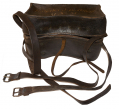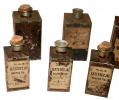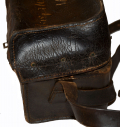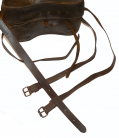site search
online catalog
RARE CIVIL WAR “SURGEON’S COMPANION” OR “U.S. ARMY MEDICINE CASE FOR FIELD SERVICE” WITH MASS VOLUNTEER MILITIA MARKINGS, LABEL, AND TINS

$7,500.00
Quantity Available: 1
Item Code: 766-2008
Shipping: Determined by Method & Location of buyer
To Order:
Call 717-334-0347,
Fax 717-334-5016, or E-mail
This scarce piece of military surgeon’s field gear is in very good condition with both the shoulder and waist belts with buckles full length, in place, and intact, as is the narrower strap buckling over the top to keep the lid closed. This follows the standard design and dimensions of the Coolidge “surgeon’s companion,” made of heavy black leather, lined on the inside with a thin brown fabric, and measuring, 13 x 6 x 7-1/2 inches, The top is stenciled in old yellow painted letters about ¾” tall, “Hospital Department. / M.V.M.” indicating it saw service in the Massachusetts Volunteer Militia, many units of which federalized for various periods of field service throughout the war, but also formed the nucleus of many of the state’s volunteer regiments.
These cases, based on a British pattern, were designed by US Army Medical Inspector R.H. Coolidge and adopted in early 1863 to replace the larger, awkward medical knapsacks of 1859 and 1862 that were to be carried in the field by a hospital orderly. The new pattern was intended to be convenient enough to be carried by the surgeon himself if necessary, slung over one shoulder to be carried on the hip, with one side contoured to fit the body, and was provided with both a shoulder and a waist strap. Like the knapsacks, it was to contain various “anaesthetics, styptics, stimulants, anodynes, and material for primary dressings,” that is: first aid materials and supplies. The lid is hinged on the straight side, the outer side as carried, secured by narrow strap sewn to the contoured side and running over the top to buckle on the outer side.
The underside of the lid has a hinged flap, forming an upper compartment for bandages, etc., as confirmed by printed illustrations and the label in this case. The main compartment was mostly for the medicines proper and has a tinned iron frame running around the top and three thin, tinned iron dividers forming four sections: one tall divider about 2 ¾” wide completely across one end; a shorter divider across the straight side of the box from that first divider to the other end, creating a long section about 1 ½” wide; a third divider, the same height runs from the second across the other end of the box to the contoured side forming a third section about 2” wide; all producing fourth section in the middle about 7 x 3-1/2.”
The official list of contents was: “6½ oz. chloroform, 2 oz. fluid extract of ipecacuanha. 2 oz. fluid extract of ginger. 2 oz. solution of persulphate of iron, 24 oz. of whiskey, 2 oz. tincture of opium, 144 compound cathartic pills, 144 colocynth and ipecacuanha pills, 144 sulphate of quinine pills, 144 opium pills, 1 yard isinglass plaster, a medicine cup, scissors, teaspoon, pins, thread, 4 oz. lint, a towel, 2 doz. bandages, muslin, and corks.” This corresponds with the printed label on the lid of the upper compartment, which includes instructions for use and a list of contents, with amounts, that includes: ROLLER BANDAGES; ICHPHYOCOLLA PLASTER; PINS; MUSTARD; SCISSORS, for the upper compartment, and for the lower compartment: “CHLOROFORM M. PURIFICATUM; EXTRACTUM IPECACUANHA FLUIDUM ZINGIBERIS; LIQUOR FERRI PERSULPHATIS PILULAE CATHARTICAE COMPOSITAE, QUINIAE SULPHATIS, OPII; PILLS OF EXT. COLOCYN COMP. and IPECAC; SPIRITUS FRUMENTI; TINCTURA OPII; LINT; MEDICINE GLASS; SPOON, TEA, TINNED IRON; SPONGE; SILK; TOWEL: CORKS.
The dividers in the lower compartment could hold appropriately sized medical tins. The 24 ounces of whiskey- “spiritus frumenti” – seem to have been held in large tin that would have been held in the wide, end section and the inner lid closing the upper compartment was provided with a hole about 1-1/2” in diameter for the spout of that tin.
The case has a brown, polished cotton lining with a large instructional and contents label about 3” by 5 ½” pasted to it, titled “U.S. ARMY MEDICINE CASE FOR FIELD SERVICE.” This shows soiling, stains, wrinkles and holes, but the title and list of contents is mostly legible and much of the middle section of instructions can be figured out. There seems to be remnants of another, smaller label at upper left, likely a retailer’s label. We note that a Coolidge case in the Wood Library-Museum of Anesthesiology, pictured online, has no instruction or contents label, only a small retailer’s label, and another has an equally large label, though with different text, indicating there were likely several makers as well as dealers, and we note that Arbittier’s excellent website on medical antiques mentions there was a second version of the Coolidge pattern, also carried on the hip, that is not pictured in Medical and Surgical History of the War and that likely had some differences in contents or design.
Inside the case are 12 original rectangular tin medicine containers, 11 of which are certainly military and 10 of which are japanned tinned iron with pewter spouts, 7 of which have corks or their remnants in place. All have full or partial labels, many noting production at the Medical Purveying Depot at Astoria, L.I. Five of the tins are about 1 ½” square on the bottom, 2 ½” tall with the spout adding another ¾,” all fitting very well in the long narrow section of the lower compartment of the case. These are all labeled “PILILLAE QUINIAE SULPHATIS.” Three others are 2” x 2” x 3 ½”, plus spout: one labeled as the first five, another Sodae et Potassae Tartras, and a third, “Extract […]etianae Fluidum.” The largest of these tins is roughly 2” x 2” X 3 ½” with slightly domed top, has a painted “34” on the top and printed on the top of the label, which indicates it, too, contained quinine pills. A narrow 1 1/2 “X 1 ½” x 3 ½ tin is labeled “Pillulae Opii.” There is also a narrower, green painted container with hinged top, about 1” x 1” x 3 ½” has a label with losses around three sides and appears to be one more for quinine pills. The last is a shorter blackened tin with screw top with a short label reading “Ipecacuanha” and with “ipecac” stenciled on top, that could date later or be a civilian addition. The large number of quinine containers would seem appropriate for a Civil War medical display: in Civil War soldiers’ opinions it was a favorite remedy for military doctors not just for malaria, but for just about anything else.
The only defect we note in the case is that the lid has become detached along the hinge. Ironically, this makes for a better display since it can be shown leaning against the case with the stenciling as well at the contents visible. The leather shows some naturally age crazing to the finish, etc., but not much flaking. The straps are solid and complete. The painted MVM designation shows some rubbing, but is fully legible. This would make a great addition to a Civil War medical display and is in much better condition than the few others we have seen. [sr][ph:L]
~~~~~~~~~~~~~~~~~~~~~~~~~~~~~~~~~~~
THIS ITEM, AS WITH ALL OTHER ITEMS AVAILABLE ON OUR WEB SITE,
MAY BE PURCHASED THROUGH OUR LAYAWAY PROGRAM.
CLICK HERE FOR OUR POLICIES AND TERMS.
THANK YOU!
Inquire About RARE CIVIL WAR “SURGEON’S COMPANION” OR “U.S. ARMY MEDICINE CASE FOR FIELD SERVICE” WITH MASS VOLUNTEER MILITIA MARKINGS, LABEL, AND TINS
For inquiries, please email us at [email protected]
Most Popular
Historical Firearms Stolen From The National Civil War Museum In Harrisburg, Pa »
Theft From Gravesite Of Gen. John Reynolds »
Selection Of Unframed Prints By Don Troiani »
Fine Condition Brass Infantry Bugle Insignia »
British Imported, Confederate Used Bayonet »
Scarce New Model 1865 Sharps Still In Percussion Near Factory New »
featured item
SILVER MOUNTED PRESENTATION WOOD FIFE OF EUGENE JEWELL 18th OHIO: CAPTURED AT STONES RIVER; HE SERVED BESIDE TWO OF HIS SONS, AND UNDER ONE OF THEM!
This is not only a real, identified Civil War fife—in contrast to the vast sea of postwar and even wartime fifes out there with bogus inscriptions and stampings- but also a great piece of Civil War military folk-art: silver-mounted, inscribed and… (1268-166). Learn More »
site search
Upcoming Events
May 16 - 18: N-SSA Spring Nationals, Fort Shenandoah, Winchester, VA Learn More »


















